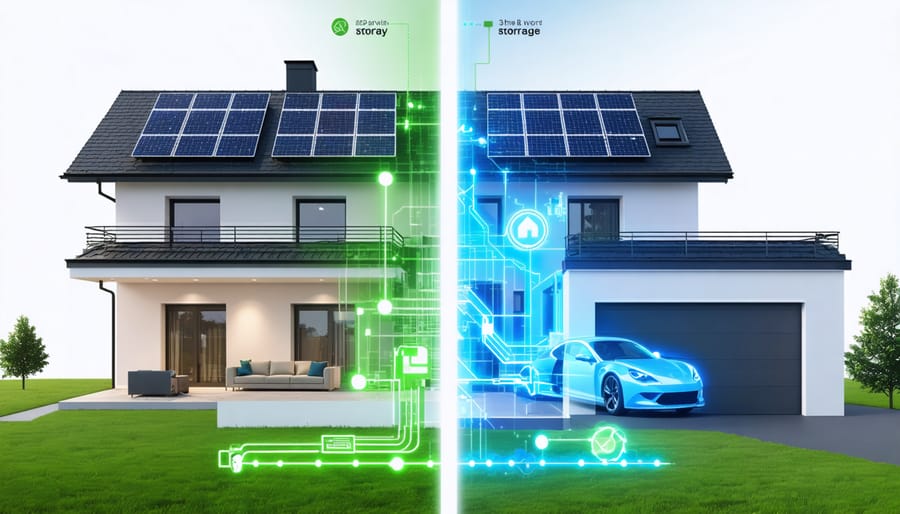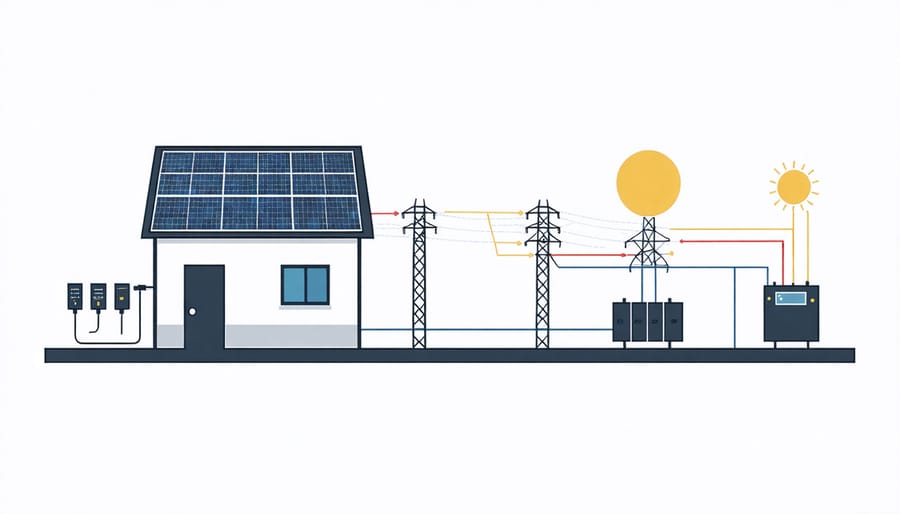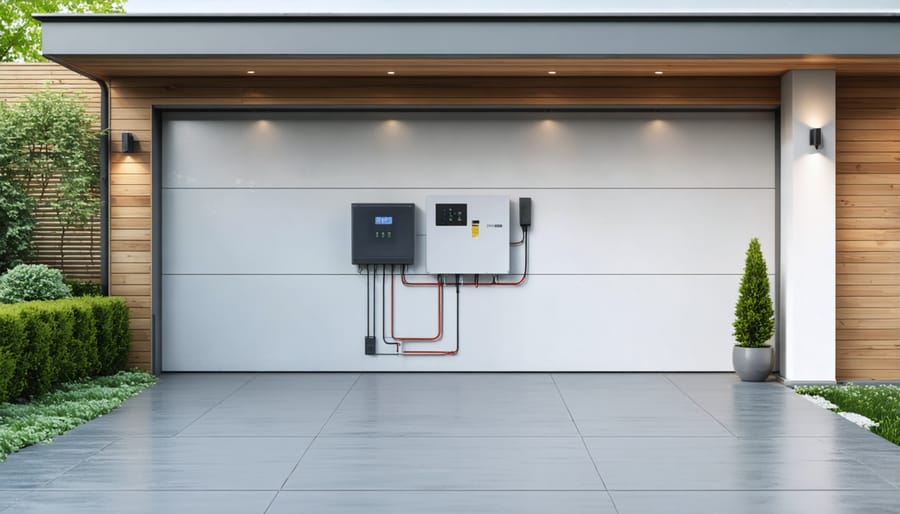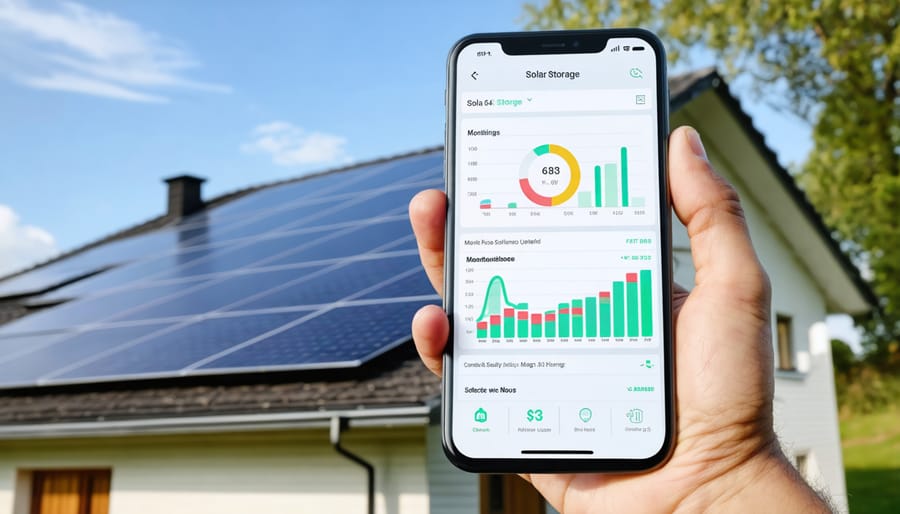
Home Battery Storage That Actually Saves You Money (And How It Works)
Transform your home into an energy-independent powerhouse with modern solar storage systems that seamlessly connect to smart home integration. Store excess solar energy during peak production hours and power your home through evenings and cloudy days, reducing grid dependency while maintaining consistent energy supply. Advanced battery systems now offer practical solutions for homeowners, combining sophisticated power management with user-friendly controls that monitor and optimize energy usage in real-time.
Gone are the days when solar panels alone meant feeding excess power back to the grid and hoping for the best. Today’s storage solutions put you in control, allowing you to capture and use every watt your panels produce. Whether you’re looking to achieve energy independence, protect against power outages, or maximize your solar investment, home energy storage systems represent the missing link between intermittent solar production and reliable, 24/7 power availability.

Why Home Solar Storage is a Game-Changer
Energy Independence Made Simple
Imagine having the power to run your home independently, even when the grid goes down. That’s exactly what a solar storage system offers. By capturing excess energy produced during sunny days and storing it in batteries, you’re creating your own personal power plant that works around the clock.
When your solar panels generate more electricity than you need, instead of sending it back to the grid, your storage system banks that energy for later use. This stored power becomes your backup during cloudy days, nighttime, or power outages, ensuring your lights stay on and your appliances keep running.
The real magic happens during power outages. While your neighbors might be in the dark, your home can continue operating normally, powered by your stored solar energy. This independence isn’t just about convenience – it’s about security and control. You’ll rely less on utility companies, potentially reducing your electricity bills and protecting yourself from rising energy costs.
For many homeowners, this self-sufficiency brings peace of mind, knowing they have a reliable power source regardless of external circumstances.
Smart Money: Peak Rate Avoidance
One of the smartest ways to slash your utility bills is by using your solar storage system to avoid peak electricity rates. Many utility companies charge higher rates during high-demand periods, typically late afternoon and early evening. With a home battery system, you can store excess solar energy produced during the day and use it during these expensive peak hours instead of drawing from the grid.
This strategy, known as energy arbitrage, allows you to buy (or generate) electricity when it’s cheap and use it when rates are high. Your system can be programmed to automatically switch to battery power during peak rate periods, maximizing your savings without any daily input needed.
Some homeowners report saving 30-40% on their monthly electricity bills through strategic peak rate avoidance. During summer months, when air conditioning drives peak rates even higher, these savings can be particularly significant. Plus, many utility companies offer additional incentives for reducing grid demand during peak hours, adding another layer of potential savings to your solar storage investment.
Key Components of a Home Solar Storage System
Battery Types and Technologies
When choosing a battery for your home solar storage system, several innovative home storage solutions are available in today’s market. Lithium-ion batteries lead the pack as the most popular choice, offering excellent energy density, longer lifespan, and minimal maintenance requirements. These batteries typically last 10-15 years and maintain consistent performance throughout their lifecycle.
Lead-acid batteries, while more affordable upfront, require regular maintenance and have a shorter lifespan of 5-10 years. They’re bulkier than lithium-ion alternatives but can be a cost-effective option for homes with ample storage space and owners willing to perform routine maintenance.
Saltwater batteries are emerging as an eco-friendly alternative, using non-toxic materials and offering similar performance to lead-acid batteries. Though currently more expensive, they’re completely recyclable and safer to handle.
Flow batteries represent the newest technology, featuring unlimited cycling capability and the potential for very long lifespans. While they require more space and come at a premium price point, they’re ideal for larger homes needing substantial storage capacity.
Each battery type offers distinct advantages, and your choice should align with your budget, available space, maintenance preferences, and energy needs. Consider factors like warranty length, cycle life, and depth of discharge when making your selection.
Smart Inverters and Control Systems
Smart inverters and control systems are the brains behind your home solar energy storage setup, managing the flow of electricity between your solar panels, batteries, and home appliances. These intelligent devices do much more than simply convert DC power from your solar panels into usable AC power for your home – they orchestrate your entire energy system to maximize efficiency and savings.
Modern smart inverters come with sophisticated monitoring capabilities that let you track your energy production and usage in real-time through user-friendly smartphone apps. They automatically adjust power flow based on your home’s needs, ensuring you’re using stored energy when it makes the most financial sense, like during peak utility rate hours.
The control systems also include important safety features that protect your equipment and home. They’ll automatically disconnect from the grid during power outages (to protect utility workers), manage battery charging cycles to extend battery life, and prevent system overload. Many smart inverters can even learn your household’s energy patterns over time, making intelligent decisions about when to store power and when to use it.
For those interested in home automation, these systems typically offer integration with popular smart home platforms. This allows you to coordinate your energy management with other smart devices, creating a truly intelligent home that optimizes both comfort and energy efficiency.
Installing Solar Storage in Your Home
Space Requirements and Placement
When installing a home solar energy storage system, proper placement is crucial for both performance and safety. The system typically consists of three main components: the battery unit, inverter, and control panel, each requiring specific space considerations.
The battery unit, often the largest component, needs a clean, dry, and temperature-controlled environment. A garage or utility room is ideal, requiring approximately 4-6 square feet of floor space and 4-5 feet of height clearance for a standard residential system. Ensure the location maintains temperatures between 50-85°F (10-29°C) for optimal battery performance.
Your inverter should be mounted on a wall near the battery unit, typically requiring about 2-3 square feet of wall space. Keep it at eye level for easy monitoring and maintenance. The control panel can be installed nearby, needing roughly 1-2 square feet of wall space.
Important placement considerations include:
– Adequate ventilation to prevent overheating
– Protection from direct sunlight and moisture
– Easy access for maintenance and repairs
– Proximity to your main electrical panel
– Safe distance from living spaces due to potential noise
– Structural support for wall-mounted components
For most homes, a total dedicated space of 40-50 square feet provides comfortable clearance for all components and maintenance access. Remember to check local building codes, as some jurisdictions have specific requirements for energy storage system placement and safety measures.
Before installation, consider future expansion needs. Leaving extra space for additional battery capacity can save you from costly reconfigurations later.

Integration with Existing Solar Systems
Adding energy storage to your existing solar system is easier than you might think, and it’s becoming an increasingly popular upgrade for solar-equipped homes. If you already have solar panels installed, you’ll need to work with a qualified installer to assess your current setup and determine the best integration approach.
Most modern solar inverters are battery-ready, meaning they can be easily connected to a storage system. However, if you have an older system, you might need to upgrade your inverter to a hybrid model that can handle both solar panels and battery storage. This is also an excellent opportunity to evaluate whether your current system size meets your energy needs.
The integration process typically involves installing a battery unit, updating or adding an inverter if necessary, and setting up a battery management system. Your installer will also need to modify your electrical panel to accommodate the new components and ensure everything meets local building codes.
When planning for future expansion, it’s wise to:
– Choose a battery system that’s modular and can be expanded later
– Install an inverter with higher capacity than currently needed
– Leave space in your electrical room for additional components
– Consider future energy needs when sizing your system
For those building a new solar installation, incorporating storage from the start can be more cost-effective. You can design the entire system as an integrated unit, potentially saving on equipment and installation costs. Many manufacturers now offer complete solar-plus-storage packages that are optimized to work together efficiently.
Smart Features and Home Automation
Mobile Apps and Energy Monitoring
Modern solar storage systems come with user-friendly mobile apps that put control right at your fingertips. These intuitive interfaces let you monitor your system’s performance, track energy production and consumption, and make adjustments from anywhere with an internet connection.
Through these apps, you can see real-time energy flow, including how much power your panels are generating, how much energy your home is using, and your battery’s current charge level. Many apps also provide detailed historical data, helping you understand your energy patterns and optimize your system’s efficiency.
Most manufacturers offer customizable settings that let you decide when to use stored energy versus grid power. For example, you can set your system to automatically switch to battery power during peak rate hours or maintain a specific reserve for backup power during outages.
Smart notifications keep you informed about system performance, maintenance needs, and potential issues. You’ll receive alerts about weather events that might affect solar production, optimal times to use stored energy, and when your batteries need attention.
The apps also integrate with other smart home devices, allowing you to create automated routines. You can coordinate your major appliances to run when solar production is highest or ensure your batteries are fully charged before forecasted storms.

Automated Energy Management
Modern solar energy storage systems leverage sophisticated AI algorithms and smart technology to maximize your home’s energy efficiency. These intelligent systems continuously monitor your energy production, consumption patterns, and weather forecasts to make real-time decisions about when to store, use, or sell excess power.
Think of it as having a personal energy manager that works 24/7 to optimize your power usage. The system learns your household’s routines and automatically adjusts to maximize savings. For example, it might store extra solar energy during peak production hours and use it during expensive evening rates, or charge your batteries when grid prices are low.
These systems integrate seamlessly with other smart home devices, creating truly adaptive environments that respond to your needs. Your storage system can communicate with smart thermostats, appliances, and EV chargers to coordinate energy usage during optimal times.
Many systems also offer mobile apps that provide real-time insights and control. You can monitor your energy production, track savings, and even manually override automated decisions when needed. Some advanced features include predictive maintenance alerts, custom scheduling options, and integration with local utility demand response programs for additional savings.
The beauty of automated energy management is that once set up, it requires minimal intervention while continuously optimizing your home’s energy efficiency and reducing your carbon footprint.
As we’ve explored throughout this guide, home solar energy storage systems represent a powerful step toward energy independence and sustainability. These systems not only provide reliable backup power during outages but also help reduce electricity bills and minimize your carbon footprint. By combining solar panels with advanced battery technology, you can store excess energy for use when you need it most, whether that’s during peak pricing hours or cloudy days.
The investment in a solar storage system may seem significant initially, but the long-term benefits – from utility savings to increased home value – make it a worthwhile consideration for many homeowners. With various financing options available and potential tax incentives, the barrier to entry is lower than ever before.
Remember to carefully assess your home’s energy needs, available space, and local regulations before proceeding with installation. Working with qualified professionals ensures your system meets all safety requirements and performs optimally. For DIY enthusiasts, while some maintenance tasks can be handled independently, professional installation is recommended for the core system components.
As renewable energy technology continues to advance and become more accessible, there’s never been a better time to embrace solar storage solutions. Take the first step toward energy independence by consulting with local solar providers and exploring the options available for your specific situation. Your future self – and the planet – will thank you.
